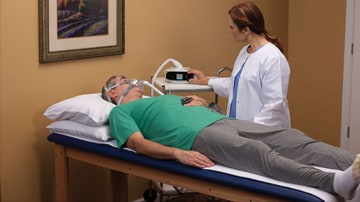Jul 10, 2017
Philips-sponsored study suggests positive airway pressure therapy could reduce COPD patient hospitalization
92 percent of the U.S. COPD patients studied did not receive PAP therapy despite possible benefits
Tucson, Ariz. – COPD hospitalizations are at an all-time high. The 30-day readmission rate for patients ranges from 20-39 percent1-3, with related healthcare costs at an estimated $50 billion4-5. A recently published study, funded by Royal Philips (NYSE: PHG, AEX: PHIA), revealed that although positive airway pressure (PAP) therapy was associated with a reduction in hospitalization, more than 92 percent of patients studied were not receiving it in any form. The retrospective study led by Dr. Sairam Parthasarathy, professor of medicine and interim chief of Division of Pulmonary, Allergy, Critical Care and Sleep Medicine with University of Arizona College of Medicine, revealed that only 7.5 percent of the more than 1.8 million COPD patients analyzed were receiving any form of PAP therapy. There are multiple modes of PAP treatment which can take place at home to help people alleviate symptoms of respiratory illness. The reviewed administrative claims data suggested that individuals receiving either Bi-level (BiPAP), continuous (CPAP) or noninvasive positive pressure ventilation (NIV) therapy (n=48,856) experienced lower hospitalization risk than before therapy initiation as well as lower hospitalization risk than those who did not receive any positive airway pressure therapy at all. “Frequent readmissions of COPD patients not only disrupt their quality of life, but are costing our health systems billions,” says Parthasarathy. “This analysis revealed that there is a solution already accessible within our toolbox that can keep patients out of the hospital, but it is significantly underutilized. With improved awareness and implementation of PAP therapy as a treatment for COPD, we can lower the cost burden for health systems while allowing patients to recover in the comfort of their own homes.” “Many clinicians still reference dated information when considering COPD treatment methods, yet technologies, machines and even masks have advanced significantly since PAP therapy was first introduced,” says Eli Diacopoulos, Philips Respiratory Care Business Leader. “This study demonstrates the vast opportunity for the industry to further adopt recent innovations for COPD treatment.” Patients with multiple chronic medical conditions were analyzed as part of this bioinformatics “real world” study. Comorbidities such as sleep apnea, chronic respiratory failure and heart failure were associated with greater benefits from PAP therapy, though ultimately, results showed that further clinical study into a causal connection between PAP therapy and reduced hospital readmissions of COPD patients is warranted. As part of its continued commitment to pioneering the development of hospital-to-home solutions designed to help people breathe easier, Philips has recently sponsored two additional studies related to COPD patient hospitalization. The first found the use of advanced home non-invasive ventilation (NIV), specifically Trilogy with AVAPS-AE, to significantly decrease hospital and payer costs as well as hospitalization rates for patients with severe COPD. Another suggested that NIV paired with home oxygen therapy can prolong the length of admission-free survival. Philips offers a wide variety of PAP therapy solutions for COPD patients, including DreamStation Advanced Therapies and its Trilogy line of hospital-to-home ventilators, each connected to the Care Orchestrator patient management application. For additional information on Philips’ PAP offerings and additional solutions for sleep and respiratory care, follow @PhilipsResp or visit www.respironics.com. 1 Jencks SF, Williams MV, Coleman EA. Rehospitalizations among patients in the Medicare fee-for service program. N Engl J Med 2009; 360:1418-1428 2 Chris K, Terra S, Andrew P. A Propensity-Matched Retrospective Analysis To Identify Predictors Of Hospitalization and readmission in chronic obstructive pulmonary disease: Am J Respir Crit Care Med. 2013; 187:A4387 3 Elixhauser A, Au D, Podulka J. Readmissions for Chronic Obstructive Pulmonary Disease, 2008. HCUP Statistical Brief #121 (AHRQ) 2011; #121. Available at: https://www.hcup-us.ahrq.gov/reports/statbriefs/sb121.pdf. Accessed March 1, 2017. 4 American Lung Association. Trends in COPD (Chronic Bronchitis and Emphysema): Morbidity and Mortality. http://www.lung.org/assets/documents/research/copd-trend-report.pdf: ALA, 2013. Accessed November 23, 2016. 5 American Lung Association http://www.lung.org/lung-disease/copd/resources/facts-figures/COPD-FactSheet.html#Sources. Accessed November 23, 2016.
About Royal Philips
Royal Philips (NYSE: PHG, AEX: PHIA) is a leading health technology company focused on improving people's health and enabling better outcomes across the health continuum from healthy living and prevention, to diagnosis, treatment and home care. Philips leverages advanced technology and deep clinical and consumer insights to deliver integrated solutions. Headquartered in the Netherlands, the company is a leader in diagnostic imaging, image-guided therapy, patient monitoring and health informatics, as well as in consumer health and home care. Philips' health technology portfolio generated 2016 sales of EUR 17.4 billion and employs approximately 70,000 employees with sales and services in more than 100 countries. News about Philips can be found at www.philips.com/newscenter.
Topics
Contacts

Meredith Amoroso
Philips Global Press Office Tel: +1 724-584-8991

Silvie Casanova
Philips North America Tel: +1 781 879 0692









